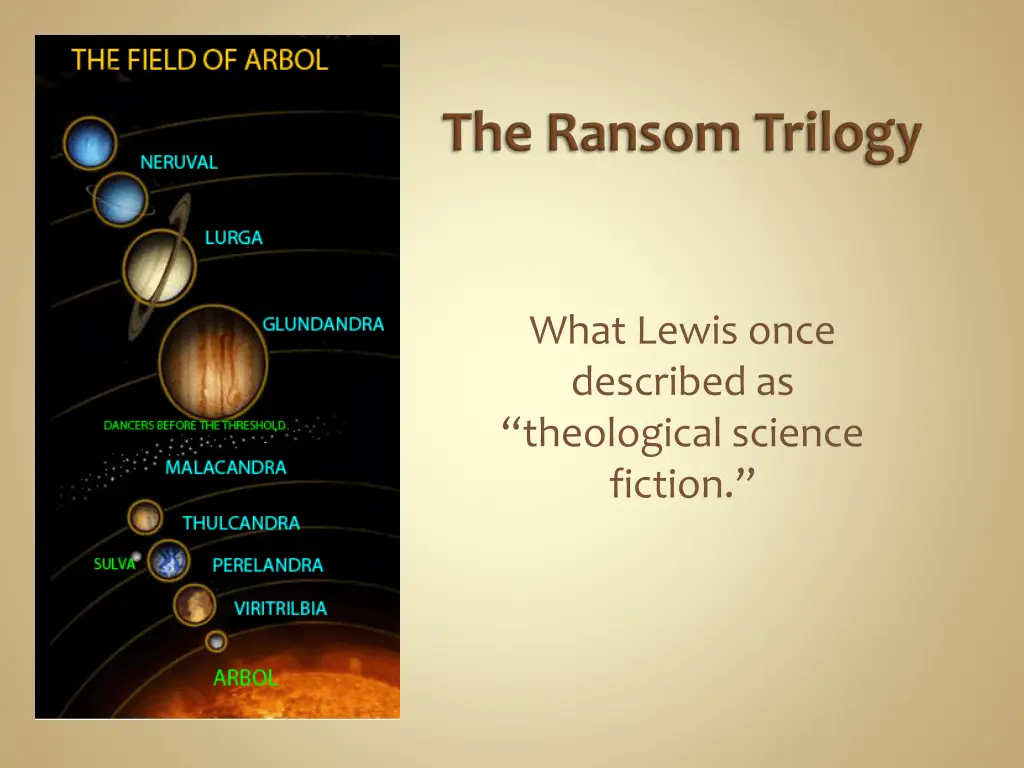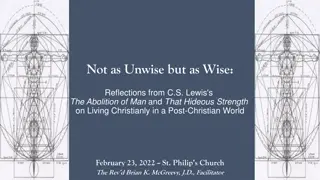
Exploring Animals, Redemption, and Divine Origins Beyond Earth
Delve into C.S. Lewis's reflection on theological science fiction, contemplating the existence of animals on other planets, their spiritual nature, redemption, and the implications of Christ's Incarnation. Lewis challenges contrasting scientific theories, questioning the Christian belief in divine origins. This exploration originated from a 1958 essay responding to Professor Fred B. Hoyle's astronomical theories, showcasing the complexity of theological debates in the context of space exploration and divine providence.
Download Presentation

Please find below an Image/Link to download the presentation.
The content on the website is provided AS IS for your information and personal use only. It may not be sold, licensed, or shared on other websites without obtaining consent from the author. If you encounter any issues during the download, it is possible that the publisher has removed the file from their server.
You are allowed to download the files provided on this website for personal or commercial use, subject to the condition that they are used lawfully. All files are the property of their respective owners.
The content on the website is provided AS IS for your information and personal use only. It may not be sold, licensed, or shared on other websites without obtaining consent from the author.
E N D
Presentation Transcript
File:FieldofArbol.png What Lewis once described as theological science fiction.
In an East African newspaper: A new swimming pool is rapidly taking shape since the contractors have thrown in the bulk of their workers. In a car rental firm in Tokyo: When passenger of foot heave in sight, tootle the horn. Trumpet him melodiously at first, but if he still obstacles your passage then tootle him with vigor. A Slovakian tourist agency: Take one of our horse- driven city tours we guarantee no miscarriages. Detour sign in Kyushu, Japan: Stop: Drive Sideways.
In a Swiss mountain inn: Special todayno ice cream. In an Austrian hotel catering to skiers: Not to perambulate the corridors in the hours of repose in the boots of ascension. In a Hong Kong supermarket: For your convenience, we recommend courteous, efficient self- service. At a Budapest zoo: Please do not feed the animals. If you have any suitable food, give it to the guard on duty.
Originally published in April 1958 in the Christian Herald and entitled Will We Lose God in Outer Space? The essay was written in partial response to the writings of Professor Fred B. Hoyle, the Cambridge astronomer and founder of the Institute of Astronomy at Cambridge.
The essay itself starts with Lewis proclaiming two equal and opposite scientific proposals: one, that life only began on earth with the rarest of accidents, and another, proposed by Hoyle, that life probably began in many places. Both positions, Lewis wrote, claim to show the absurdity of the Christian belief in divine origins and the Incarnation of Christ. The odd thing is that arguments from two very different positions would both be used to attack Christianity, but such is the desperation of the anti- religionist.
1. Are there animals anywhere else besides earth? 2. If yes, do any of these animals have what we call rational souls ? That is, are they spiritual beings? 3. If there are such spiritual beings, are any or all of them, like us, fallen? 4. If any of them have fallen, have they been denied Redemption by the Incarnation and Passion of Christ? Christ could have come to those worlds also. 5. Finally, if all of the first four questions could be answered yes, is it certain that this is the only possible mode of Redemption?
http://booksbycslewis.blogspot.com/2008/04/religio n-and-rocketry.html
Dr. Elwin Ransom, Edward Weston, Dick Devine Elwin means Elf friend in Anglo-Saxon Malacandra (Mars) Three types of creatures: hrossa, pfifltriggi, sorns Dr. Ransom, a Cambridge academic, is abducted and taken on a spaceship to the planet of Malacandra. His captors are plotting to plunder the planet s treasures and plan to offer Ransom as a sacrifice to the creatures who live there. Ransom discovers he has come from the silent planet Earth whose tragic story is known throughout the universe! An unfallen world The Oyarsa of Malacandra
According to the medieval mind, the music of the spheres meant that each planet sounded a note. If there is harmony among the planets, all planets sound a note and form a beautiful chord. One planet is ruled by a fallen angel, who does not participate in this harmony, so it does not make a sound. It is silent. Hence, earth is the silent planet. One other note: when Ransom first sees the Earth from Malacandra (Mars), he sees it upside down (next slide).
Have you ever wondered what might have happened if Adam and Eve had not eaten the forbidden fruit? Lewis did too, and he wrote Perelandra to tell us, not what he thought might have happened, but to speculate about another world in a similar situation.
File:CSLewis Perelandra.jpg It all began with a picture . . . . . . of floating islands Reality in story form Suppose . . . In some other planet there were a first couple undergoing the same that Adam and Eve underwent here, but successfully. (Dec. 29, 1958, in a letter to Mrs. Hook)
Lewis liked this book best among all his books. Dr. Ransom s voyage to the paradise planet of Perelandra, or Venus, which turns out to be a beautiful Eden-like world. He is horrified to find that his old enemy, Dr. Weston, has also arrived and is attempting to cause the first sin by Perelandra s Eve. As the mad Weston s body is taken over by the forces of evil, Ransom engages in a desperate struggle (during which his heel is wounded) to save the innocence of Perelandra and its first two humans, Tor and Tinidril, the Adam and Eve of Venus!
Theme: Lewiss main theme in Perelandra The question is how can a totally free person, without unfair manipulation by God, spontaneously carry out what God most desires, and find herself a destiny which God fully intends (Walter Hooper 222).
Leonard Bacon (1946): the poetic imagination in full blast. John Gilland Brunini (1944): The book can be ranked high in the fields of creative imagination, speculative theology and engrossing adventure far superior to other tales of interplanetary adventures. Victor M. Hamm (1945): The substance of this wonderful scene (i.e., the description of the Oyarsa of Mars and the Oyarsa of Venus) which culminates in a grand chorus of praises to Maleldil [is] an inspired litany of love and homage.
The title comes from the line of a poem written in 1555 by David Lyndsay, referring to the Tower of Babel. Remember that this is the novelistic embodiment of Lewis 1943 book, The Abolition of Man. This story is set on Earth, and tells of a terrifying conspiracy against humanity. The story centers on Mark and Jane Studdock, a newly married couple. Mark is a sociologist who is invited to join an organization called the N.I.C.E., which is not so nice, and aims to control all human life. Meanwhile, his wife has bizarre prophetic dreams about a decapitated scientist, Alcasan.
As Mark is drawn into the sinister organization, he discovers the truth of his wife s dreams when he meets the literal head of Alcasan which is being kept alive by infusions of blood. Jane seeks help concerning her dreams at a community called St. Anne s, where she meets their leader Dr. Ransom (the main character of the previous two titles in the trilogy). In the end the angelic spirits of the planets descend to Earth to save the day. The story ends in a final spectacular scene at the N.I.C.E. headquarters where Merlin (the magician from the age of King Arthur) appears to confront the powers of Hell.
The King Arthur stories Chaucer, e.g., the poem Troilus and Criseyde Beowulf (in Old English) Dante s The Divine Comedy The Romance of the Rose, Guillaume de Lorris and Jean de Meun Works by John Gower (Confessio Amantis), Thomas Usk, and John Lydgate Thomas Aquinas Summa Theologica (everything in its place) Dante s Divine Comedy (Hell, Purgatory, Paradise)
Its artistic and aesthetic splendor The personalized society The sense of order and hierarchy The bond between church, kings, and aristocracy A chivalric society tied to land and nature
Renaissance The Allegory of Love The Discarded Image Both the Chronicles of Narnia and the Ransom Trilogy attempt to recover some of that. What is medieval in Lewis s fiction: language, dress, polity, geography & transportation, weaponry, cosmology, customs, creatures, astronomy, and clothing
Language: hastilude, gentilesse, estres, pajock, seneschal, cantrips, and dromonds. Clothing: silk and cloth of gold snowy linen glancing through slashed sleeves silver mail shirts and jeweled sword hilts gilt helmets and feathered bonnets in Prince Caspian. Polity: Narnia as a medieval definition of kingdom Geography: Narnia is flat, not spherical Cosmology: the planets have influences in TSC Astrology: planetary influence (Dr. Cornelius, the centaur Glenstorm, and the centaur Roonwit) Cartography: more like a medieval map than an Ordnance Survey
Buildings: castles, walled cities Transportation: horseback, ship, bipedalism Weaponry: catapult, crossbow, bow and arrow, sword (the same is true in Malacandra) Creatures: fauns, satyrs, tree nymphs, giants, gnomes, dwarves, dragons, centaurs Deities: Bacchus, Pomona Customs: storytelling (the same is true in Malacandra) Education: grammar, logic, and rhetoric (and the Four Cardinal Virtues)
Earth at the center, motionless, not considered a planet because it did not wander (planet means wanderer ) Surrounded by seven hollow, perfect concentric circles Lowest globe was the moon Then Mercury, Venus, the Sun, Mars, Jupiter, Saturn, and the sphere of the Fixed Stars (7 globes) Then the Primum Mobile Then the Empyrean, or true Heaven For example, Dante s Divine Comedy The Great Dance
The word space was used for the heavens only since the 17th century.
The Great Dance: order and freedom The Great Chain of Being (Perelandra, Malacandra) The Old One Maleldil the Young Oyarsa The King The Green Lady Animals Human Personality: concentric circles (next slide) Nine Classes of Angels (second slide) The Old One Maleldil the Young Oyarsa Eldila Hnau Animals
Imagination Intellect Will
Name Seraphim Cherubim Thrones Dominations Virtues Powers Principalities Archangels Angels Orientation (3 + 3 + 3) closest to God look God-ward contemplate the Divine essence; unconcerned with the created universe; associated with heat, burning face God with backs to earth responsible for general order of Nature potentially active deal with destiny of nations deal with individuals deal with individuals
The unity of spirit and matter, God and mankind, language and reality Order and hierarchy vs. disorder (Space, Music, Dance) everything is ordered Vitality of space Discipline vs. free spirit God-centered vs. man-centered The reality of sin Creative majesty Chivalry Aesthetic splendor C. S. Lewis: I have made no serious effort to hide the fact that the old Model delights me as I believe it delighted our ancestors. Few constructions of the imagination seem to me to have combined splendor, sobriety, and coherence in the same degree (The Discarded Image, 216).






















